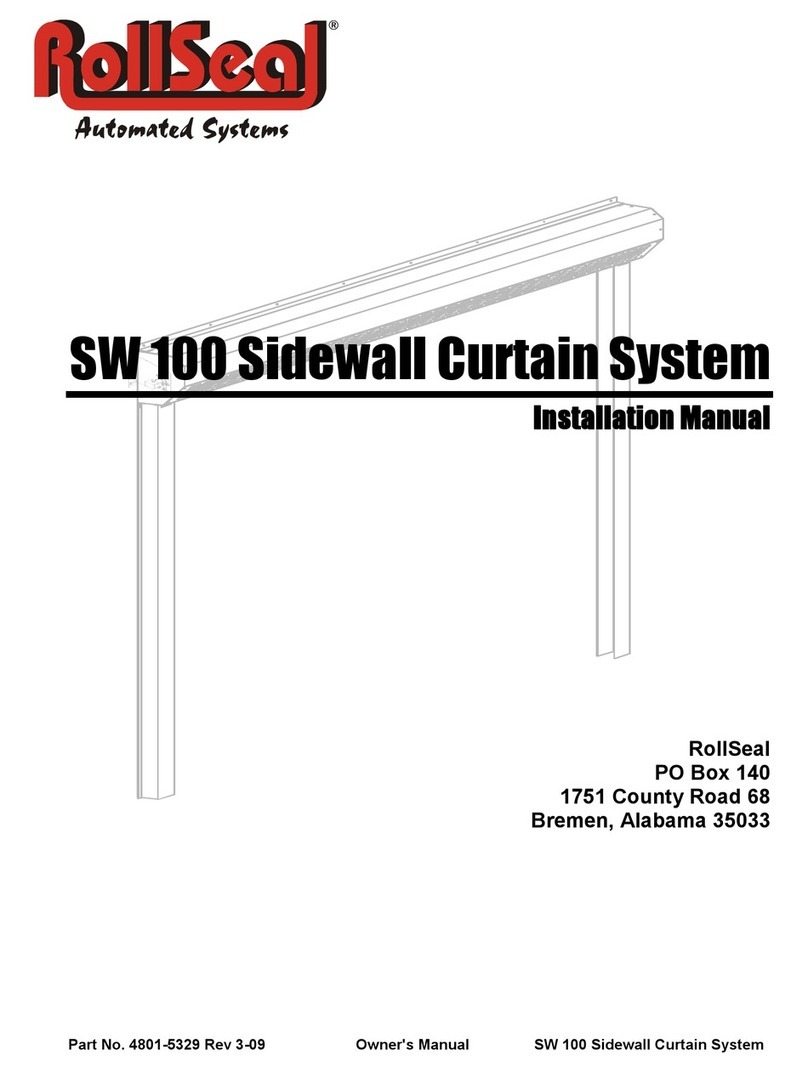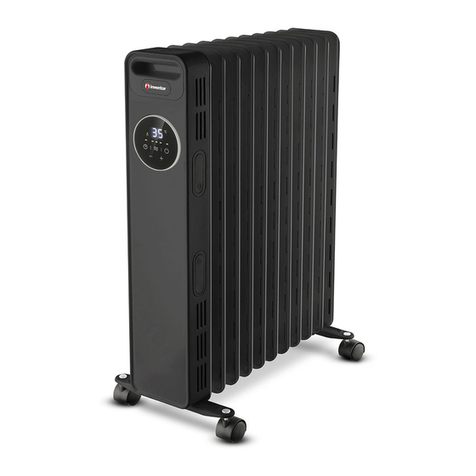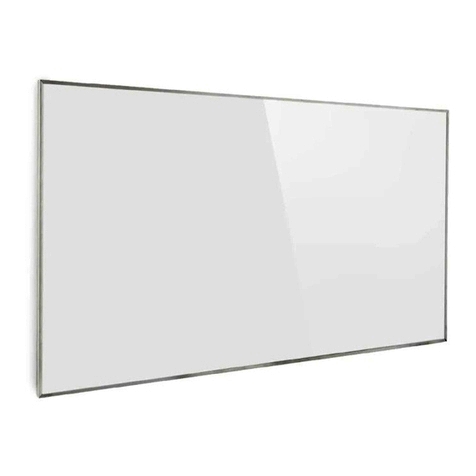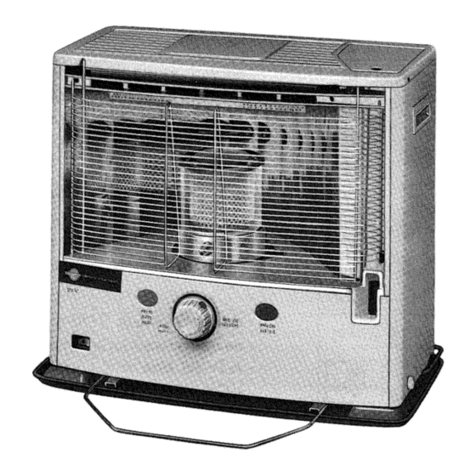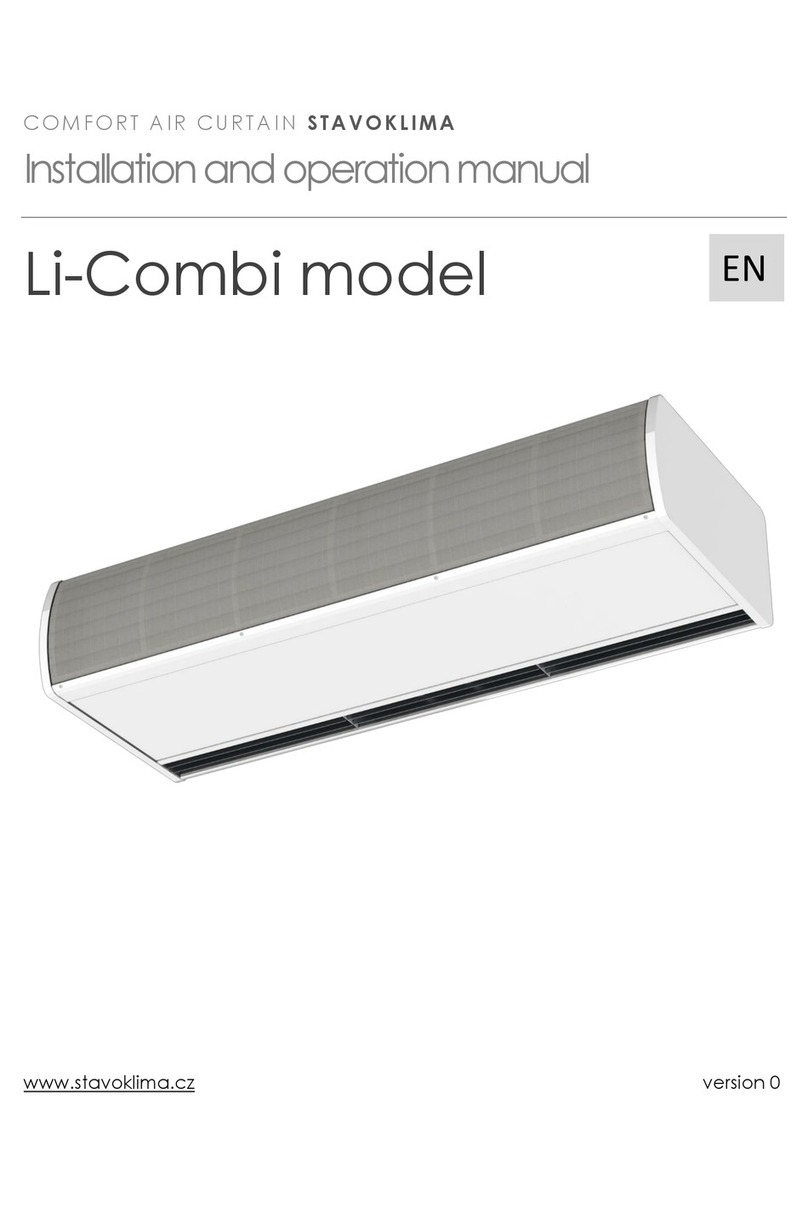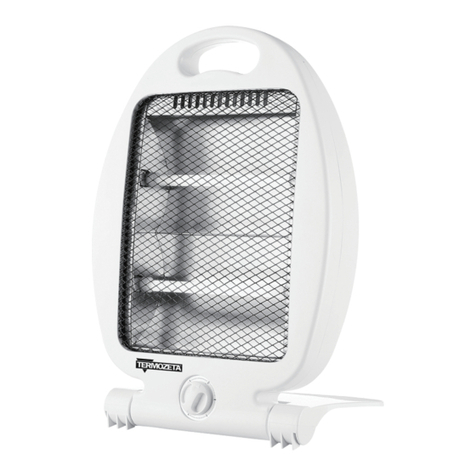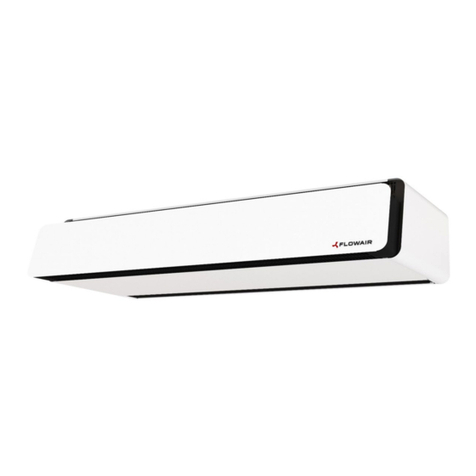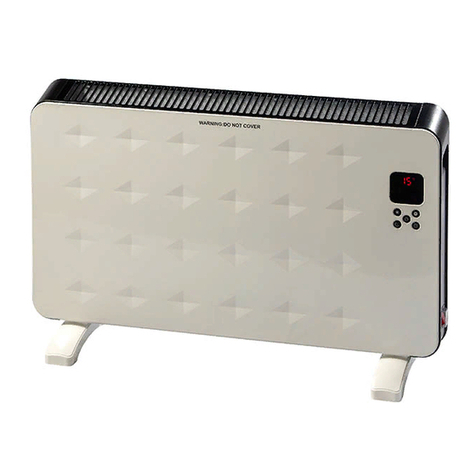RollSeal 100 User manual

Part No. 4801-2987 Owner’s Manual Unit Heater
Canadian Gas Association
Association Canadian du Gaz
MODELS BTUH
100 83,000
240 240,000
300 249,000
Retain These Instructions For Future Reference
ANS IAS U.S. LC2-1996
RUNIT HEATERUNIT HEATER
RollSeal
PO Box 140
1751 County Road 68
Bremen, AL 35033
For Your SafetyFor Your Safety
If you smell gas:
1. Open windows.
2. Do Not Touch Electrical Switches.
3. Extinguish Any Open Flames.
4. Immediately Call Your Gas Supplier.
For Your SafetyFor Your Safety
The Use And Storage Of Gasoline Or Other Flammable
Vapors And Liquids In Open Containers In The Vicinity
Of This Appliance Is Hazardous.
Warning
Not For Home Or Recreational Use. Installation Of This
Heater In A Home Or Recreational Vehicle May Result In
A Fire Or Explosion, Property Damage Or Loss Of Life.
!

Part No. 4801-2987 Warnings Unit Heater
!
WARNING
Proper Gas supply pressure must Be Provided To The Appliance. Refer To
Rating Plate For Proper Gas Pressure. Gas Pressure In Excess Of The
maximum Inlet Pressure Specified At The Appliance Inlet Can Cause Fires Or
Explosions, Leading To Serious Injury, Death, Building Damage Or Loss Of
Livestock.
Gas Pressure Below The Minimum Inlet Pressure Specified At The Appliance Inlet
May Cause Improper Combustion, Leading To Asphyxiation, Carbon Monoxide
Poisoning And Therefore Serious Injury Or Death To Humans And Livestock.
!
WARNING
Improper Installation, Adjustment, alteration, Service Or maintenance Can Cause
Property Damage, Injury Or Death. Read The Installation, Operating, And
Maintenance Instructions Thoroughly Before Installing Or Servicing This Equipment.
!
WARNING

Part No. 4801-2987 Unit Heater Table Of Contents
Table Of Contents
1. Specifications And Requirements............................................................................................1
1.1 Natural Gas and Propane Gas Requirements....................................................................1
1.2 Ventilation Requirements...................................................................................................1
2. Warnings....................................................................................................................................2
3. Limited Warranty.......................................................................................................................3
4. Use Of Equipment .....................................................................................................................3
5. Physical Description/Drawing...................................................................................................4
5.1 Heater Views....................................................................................................................4
5.2 Table 2 Heater Dimensions...............................................................................................4
6. Installation.................................................................................................................................5
6.1 Installation Overview..........................................................................................................5
6.2 Tools Required..................................................................................................................5
6.3 Receiving and Unpacking..................................................................................................5
6.4 Hanging Or Floor Mounting................................................................................................5
6.4.1 Hanging The Heater ............................................................................................5
6.4.2 Floor Mounting The Heater..................................................................................6
6.5 Flue Pipe Installation .........................................................................................................6
6.5.1 Flue Connector And Size Adapter........................................................................6
6.5.2 Flue Pipe.............................................................................................................7
6.6 Connecting The Gas Supply..............................................................................................8
6.6.1 Pipe Sizing For Sufficient Gas Service.................................................................8
6.6.2 Connecting Heater To Gas Supply.....................................................................11
6.7 Connecting The Power Cord And Thermostat..................................................................11
6.8 Heater Startup.................................................................................................................12
6.9 Heater Shutdown.............................................................................................................12
7. MAINTENANCE........................................................................................................................13
7.1 General Maintenance ......................................................................................................13
7.2 Trouble Shooting The Direct Spark Ignition System .........................................................13
7.3 Checking The Manifold Pressure .....................................................................................14
7.4 Checking Gas Valve Operation........................................................................................15
8. Wiring Diagrams, Schematics, etc..........................................................................................16
8.1 Direct Spark Ignition System............................................................................................16
9. Exploded View And Parts........................................................................................................17

Part No. 4801-2987 Unit Heater 1
1. Specifications And Requirements
1.1 Natural Gas and Propane Gas Requirements
Natural Gas: An average of 9.5 in. water column (W.C.) [19.4 mbar] with a
maximum 14 in. W. C. [34.8 mbar] and minimum 5 in. W. C. [12.5 mbar] inlet gas
supply pressure is acceptable at the gas regulator connection. Burner manifold gas
pressure is to be 3.5 in.
W. C. [8.7 mbar] at maximum input. Gas pressure should be checked by a certified
gas technician while heater is in operation with maximum load on the supply.
Liquid Propane: An average of 13 in. W.C. [33.6 mbar] with a maximum of 14 in.
(W.C.) [34.8 mbar] and a minimum 12.5 in. W.C. [31.1 mbar] inlet gas supply is
required at the gas valve. Burner manifold pressure is to be 11 in. W. C. [27.4 mbar]
at maximum input rating. Gas pressure should be checked by a certified gas
technician while the heater is in operation with maximum load on the supply.
1.2 Ventilation Requirements
Air for combustion and ventilation must be provided in accordance with National Flue
Gas Code ANSI Z223.1 in U.S.A. and CAN/CGA B149 Installation Code in Canada
and in accordance with local building codes. Indoor air must be free from all airborne
corrosive chemicals including: chlorine, carbon tetrachloride, varnishes, fluorides,
printing inks, cements, and glues, paints or paint removers, halogen refrigerants, and
cleaning solvents. See Table 1 for combustion air volume requirements (CFM, cubic
feet/minute).
1.3 Table 1 Specifications Model Numbers
100 200 300
Heating Capacity Input Btuh (kW) 100,000 (29.3) 200,000 (58.6) 300,000 (87.9)
Heating Capacity Natural Gas 83,000 (24.3) 166,000 (48.6) 249,000 (72.9)
Output (Btuh) Liquid Propane 82,000 (24.0) 164,000 (48.0) 246,000 (72.0)
Steady State Efficiency Natural Gas 83% 83% 83%
Liquid Propane 82% 82% 82%
Gas Pipe Size in. (mm) Natural Gas 1/2 (12.7) 1/2 (12.7) 3/4 (19)
Liquid Propane 1/2 (12.7) 1/2 (12.7) 3/4 (19)
Combustion Air Volume Requirements CFM 500 1000 1500
Flue Diameter in. (mm)14 (102) 5 (127) 6 (152)
Fan Diameter in. (mm) (No.of props) 16 (406) (1) 16 (406) (2) 16 (406) (3)
Fan Motor2hp (kW) (No. of motors per unit) 1/3 (247) (1) 1/3 (247) (2) 1/3 (247) (3)
Shipping Weight lbs. (kG) 125 250 375
Electrical Requirement volts (cycles/second) 115 (60) 115 (60) 115 (60)
Top 6(152) 6(152) 6(152)
Minimum Clearances Side 6(152) 6(152) 6(152)
From Adjacent Surfaces Bottom 0(0) 0(0) 0(0)
in. (mm) Rear 6(152) 6(152) 6(152)
Flue 18(457) 18(457) 18(457)
1Flue connector is supplied with heater.
2115V 60Hz single phase, 1100 rpm.
CAUTION: Insufficient combustion air volume can result in excessive CO
(carbon monoxide) production resulting in sickness or death.

Part No. 4801-2987 Unit Heater 2
2. Warnings
•For indoor installation only.
•Installation must comply with local, state, and national codes, or in the absence of
local codes, in accordance with the National Fuel Gas Code, ANSI Z223.1.
•Follow safety, maintenance, and test firing instructions packaged with heater.
•Refer to model specifications label gas type (LP/Propane or Natural Gas).
•Check all connections for gas leaks.
•Gas supply and regulator must be installed outside building.
•The gas hose assembly should be protected from traffic, building materials, and
contact with hot surfaces both during use and while in storage.
•This heater is equipped with a three prong (grounding) plug for your protection
against electrical shock and should be plugged directly into a properly grounded
three prong receptacle.
•Turn off power and disconnect gas supply before servicing . This heater is equipped
with Direct Spark Ignition system and may start at any time.
•Do not use this heater to heat human living quarters.
•Do not use or store flammable materials near this appliance.
•Inadequate gas volume and (or) pressure will directly influence the combustion
efficiency of the heater. Adequate gas volume and(or) pressure is the responsibility
of the installer.
•Adequate ventilation must be provided.
•Do not place articles on or against this appliance.
•WARNING: Do not enclose this appliance.
•Do not spray aerosols in the vicinity of this appliance while it is in operation.
•The heater must be level and in accordance with minimum clearances.
•For safety, the heater is equipped with a manual reset high limit switch - NEVER
BYPASS THE RESET SWITCH.
•The heater shall not be connected to any portion of mechanical draft systems
operating under positive pressure.
Heater requires minimum clearance of 6"
from sides and top, 0" from bottom and
18" from rear to adjacent surfaces.
Discharge outlet must be a minimum of 10
feet from combustible material.
!
Warning!
Explosion Or Fire May result From Improper Heater Installation
Please Read And Understand The Following Precautions
Heaters surfaces may be hot. Do not
Permit feathers, hay, straw, dust, or other
combustible materials to accumulate on
heater. A fire may result.
WARNING:
CAUTION:

Part No. 4801-2987 Unit Heater 3
3. Limited Warranty
All products are warranted to be free from defects in material and workmanship for a
period of one year from the date of purchase if installed and used in strict
accordance with the installation instructions. Liability is limited to the sale price of
any products proved to be defective or, at manufacturers option, to the replacement
of such products upon their return. No products are to be returned to the
manufacturer, until there is an inspection and/or a return-goods authorization (RGA)
number is issued.
All complaints should be directed first to the authorized distributor who sold the
product. If satisfaction is not obtained or the name of the distributor is not known,
write the manufacturer that appears below, directed to the attention of Customer
Service Manager.
This limited warranty is expressly in lieu of any and all representations and
warranties expressed or implied, including any implied warranty of merchantability or
fitness for a particular purpose. The remedy set forth in this limited warranty shall be
the exclusive remedy available to any person. No person has authority to bind the
manufacturer to any representation or warranty other than this limited warranty. The
manufacturer shall not be liable for any consequential damages resulting from the
use of our products or caused by any defect, failure or malfunction of our products.
(Some areas do not allow the exclusion or limitation of incidental or consequential
damages, so the above limitation or exclusion may not apply to you.)
This warranty gives you specific legal rights and you may also have other rights that
vary from area to area.
Warrantor:
RollSeal
PO Box 140
1751 County Road 68
Bremen, AL 35033
4. Use Of Equipment
The heater is recommended for use in Greenhouse environments, but is an
excellent heat source for any large scale enclosures such as garages, utility
buildings, workshops, parking structures, auditoriums and other similar
building enclosures.

Part No. 4801-2987 Unit Heater 4
5. Physical Description/Drawing
5.1 Heater Views
5.2 Table 2 Heater Dimensions
Model Numbers
100 200 300
Outer Dimensions in. mm in. mm in. mm
A 43 1/2 1105 43 1/2 1105 43 1/2 1105
B 28 1/2 724 28 1/2 724 28 1/2 724
C 11 1/2 292 11 1/2 292 11 1/2 292
D 21 1/2 546 41 3/4 1060 61 1549
E 19 1/2 495 38 3/4 984 58 1473
F 37 1/8 943 37 1/8 943 37 1/8 943
Mounting Holes
H 18 3/8 467 37 5/8 956 56 7/8 1445
I 20 3/4 527 20 3/4 527 20 3/4 527
J -------- ------ -------- ----- 28 7/16 527
Note: Center Hole J
For Model 300 Only
ABC
H
J
TOP
ED
FRONT
F
SIDE
I
Note: 1/4-20 Thread
Size Recommended
NOTE: Overall Length, Width, and Height given by Dimensions A,D, F, respectively.

Part No. 4801-2987 Unit Heater 5
6. Installation
6.1 Installation Overview
The installation of your new Unit Heater requires a few easy-to-follow steps.
These steps are described below. You will need to gather the required tools,
choose a suitable area for locating the heater, install either hanging mounts or
a floor support mount for the heater, install the flue system and flue pipe,
connect the gas supply, install the power cord and thermostat to the heater
control box, and test the heater.
This manual provides a general description of the flue pipe installation in
Section 6.5. It is recommended that the flue be installed by a trained
experienced service technician. The heater mounting requires advanced
planning. For example, if a mounting frame or support is required, this will
need to be constructed and installed in advance. It is recommended that
electrical outlets be installed by a certified electrician.
6.2 Tools Required
Adjustable Wrench
Hammer or Drill to Install Screw Hooks in Ceiling
¼” Nut Driver
Pipe Glue
Gas Leak Testing Solution (A soap and water solution works well).
6.3 Receiving and Unpacking
Your heater is shipped completely assembled except for the power cord and
thermostat which you will have to attach to the control box. Unpack the
heater and check for any shipping damage. If you suspect shipping damage,
contact your local Distributor.
6.4 Hanging Or Floor Mounting
In order to ensure proper ventilation and safety, the heater requires minimum
clearances of 6 inches from each side of the heater, a minimum of 6 inches
from the top of the heater, 18 inches from the back of the heater, and requires
6 inches from the flue pipe to adjacent surfaces. The heater must be
positioned so as to prevent contact within 10 feet of the hot air discharge from
the front of the heater. Choose a location of the heater which isolates heater
from accidental drafts and permits installation of a flue pipe (See Section 6.5;
See Section 1.2 Ventilation Requirements, page 1).
6.4.1 Hanging The Heater
Model 100 and Model 200 are designed to be suspended from the Top only.
Model 300 can be suspended from either the Top or the Bottom, as desired.
To prepare the heater for hanging, you will have to install threaded hooks,
eyebolts, or rods into the mounting holes of the heater. Locate the mounting

Part No. 4801-2987 Unit Heater 6
holes designed for receiving the hooks or rods. These hole locations are
labeled as H, I, and J in Section 5.1, page 4. For Model 300, there are ten
holes on the Top and ten holes on the Bottom which may be used to hang the
heater. The thread size of the mounting holes is 1/4-20.
The method of supporting the heater is the installer’s choice and
responsibility. Install the desired suspension supports into the ceiling. Make
sure that the ceiling supports are adequate to support the weight of the
heater. Screw the mounting holes of the heater appropriately threaded rods,
hooks, or eyebolts being used to attach cables or chains. Lift the heater into
position and suspend the heater on the previously installed ceiling supports.
Make sure to allow the required separation distances between the heater and
the ceiling and walls as described above and in Table 1.
6.4.2 Floor Mounting The Heater
If the heater is mounted on a floor stand, make sure that the stand has
sufficient strength to support the heater. Make sure that the heater is
securely attached to the stand, and that the heater and stand are not top-
heavy or unstable. It is recommended to secure a floor stand to the floor with
bolts. Be sure to construct the floor stand from non-combustible materials.
6.5 Flue Pipe Installation
Unit heaters must be vented in compliance with local codes, and within
standards of the American National Flue Gas Code, ANSI Z-223.1 or Canada
CAN/CGA-B149 installation codes. Flue gases are exhausted through the
exhaust blower on the rear of the heater, and must be vented to the outside of
the building through a flue system. The flue system is the responsibility of the
installer. It is recommended that the flue pipe be installed by an authorized
heater representative.
6.5.1 Flue Connector And Size Adapter
The exhaust blower must be coupled to the flue by attaching a flue connector
which is included with your heater. Attach the flue connector to the exhaust
blower as shown in Figure 1, page 7. Secure the flue connector with non-
corrosive screws. The flue connector output has a 4” diameter. A size
adapter must be attached to change diameters of the flue pipe. The size
adapter is not supplied with the heater. The size adapter is a metal vent pipe
which transitions from a 4” diameter to 5” diameter for Model 100, 6” diameter
for Model 200, or 7” diameter for Model 300. After attaching the flue
connector and size adapter, all seams and joints must be sealed with high
temperature jointing compound or jointing material such as aluminum tape.
Aluminum tape must meet the SMACNA AFTS-100-73 Standards. Silicone
rubber sealant must have a temperature rating of at least 400 degrees
Fahrenheit. All joints must be checked for tightness of fit after installation.

Part No. 4801-2987 Unit Heater 7
6.5.2 Flue Pipe
Refer to Figure 2, page 8. The flue is composed of short sections and elbows
of metal vent pipe joined together to connect the heater to the flue terminator
which extends to the outside of the building. The flue diameter is 4” for
Model 100, 5” diameter for Model 200, or 6” diameter for Model 300. All joints
and seams of the flue pipe must be sealed with high temperature silicon
rubber sealant or aluminum tape. The flue should be as short as possible
and have a minimum number of elbows. All joints must be secured by at
least two screws. After installation of the flue, check all joints for tightness.
Refer to National Standards NFPA 54/ANSI Z223.1 for U.S.A. or Canada
Standard CAN/CGA B149.1 and B149.2. If using a high temperature plastic
flue pipe (instead of metal), the first 18 inches of pipe extending from the flue
connector must be metal to prevent heat damage. The horizontally running
sections of the flue must normally maintain a slope of 1/4” rise per each foot
of horizontal run of the flue. The flue pipe should be supported with hangers
no more than 3 feet apart to prevent movement. Install a condenser tee and
drain within the first 5 feet of the heater. If a fume trap is used, be sure to
keep it filled with water.
The flue pipe must be 6 feet or more from an inside corner formed by two
exterior walls. If a single wall flue is used in an unheated area it should be
insulated with fiberglass to prevent excess condensation of flue gases.
If the flue pipe passes through a combustible wall, an insulating thimble
should be used (See Figure 2, page 8).
After passing through an outside wall, the flue pipe should be turned vertically
using an elbow. The vertically running segment of the flue pipe should be at
least 12 inches from the outside wall. The outside segment of the flue pipe
should extend vertically to at least 3 feet above the highest point of the roof
and should be terminated with a flue cowl.
Model 100 4” Diameter
Model 200 5” Diameter
Model 300 6” Diameter
Size Adapter
4” Diameter
(Not Supplied)
Flue Connector
(Supplied With Heater)
Exhaust Blower
Figure 1

Part No. 4801-2987 Unit Heater 8
6.6 Connecting The Gas Supply
The heater is shipped ready to connect to the regulated gas supply line.
It is the responsibility of the installer to have either a Natural Gas or a Liquid
Propane supply line with a regulator installed by a certified gas supplier.
The acceptable maximum and minimum pressures of the gas supply line
are given in Section 1.1, page 1. Refer to Section 6.6.1 for pipe sizes.
6.6.1 Pipe Sizing For Sufficient Gas Service
1. Using a system schematic, label each piping section of the system starting
at the meter or regulator. A different pipe section starts where the gas
demand of the system changes, usually at a junction.
2. Determine the Heating Value Required (HVR) in BTU/hr for each section
of pipe. HVR = (# heaters supplied with gas by pipe section) x (heat
output per heater).
Figure 2 Suspend Heater From Ceiling
With Cables Or Chains
This terminal must always
Vent to the outside atmosphere
Maintain ¼” Upward Slope
Per Foot Of Horizontal Run
Or Mount Heater On A Floor Support
Minimum horizontal clearance of
4 feet (1.22 m) from electric
meters, gas meters, regulators,
and relief equipment.

Part No. 4801-2987 Unit Heater 9
3. Determine the Equivalent Length Of Pipe (ELOP) required for sufficient
gas service. ELOP = (length from meter to most remote heater) + (Minor loss
equivalents of the system). Important: Use the ELOP value from this equation for
size determination of all pipe sections.
4. Use the ELOP value from step 3, and the HVR of each pipe section to
determine the required pipe size from table ‘Maximum Capacity of Pipe’ for either
Natural Gas (Table 4) or LP (Table 5).
Directions For Reading Pipe Size From Tables:
EXAMPLE: Four 40,000 BTU/hr heaters will be installed on the gas pipe line as in the
Arbitrary Piping System Diagram below.
1. Refer to the pipe sections labeled in diagram below.
2. Determine the HVR value of each pipe section of the system.
3. Determine ELOP:
Length from meter to most remote heater = length from a to e (or g) = 100ft + 25 ft
=125 ft. Minor loss equivalents from Table 3 = (1 gate valve) x (2ft / valve) + (3
tees) x (11ft / tee) = 35 ft. ELOP = 125 ft + 35 ft = 160 ft Round up to nearest Table
value: ELOP = 200 ft.
4. In the appropriate table, NG (Table 4) or LP (Table 5), select the column showing
the ELOP or the next longer length if the table does not give the exact length. Use
this column to compare table values to the HVR values. In this example, the Natural
Gas (NG) table is selected. From step 3, ELOP = 200 ft. Locate the column labeled
200 ft in. Table 4 .
Pipe Section # Heaters HVR Calculation
(BTU/hr) HVR Value
(BTU/hr)
a-b 4(4) x (40,000) 160,000
b-c 2(2) x (40,000) 80,000
c-e 1(1) x (40,000) 40,000
b-d 1(1) x (40,000) 40,000
b-f 1(1) x (40,000) 40,000
c-g 1(1) x (40,000) 40,000
Table 3
Minor Loss Equivalents
(feet per fitting)
Fitting 2”IPS 2” IPS
Or Smaller To 4” IPS
45°Elbow 3 5
90°Elbow 6 10
Tee 11 20
Gate Valve 2 3
Angle Valve 30 60
Swing Valve 15 30
IMPORTANT
The piping diagram at left is for example only
and in no way demonstrates proper heater
placement or gas line configurations. Minor
loss equivalent values will vary depending
upon your system configuration.
Arbitrary Piping System
b
Gate
valve
ac
de
f
g
Heaters
100 ft
meter
25 ft
tees
Heaters
25 ft

Part No. 4801-2987 Unit Heater 10
5. Select a pipe section and read down the ELOP column to find the maximum gas
capacity that matches the HVR for that pipe section. If the exact figure is not shown,
choose the next larger figure in the column. In this example, start with pipe section c-e.
For pipe section c-e, HVR = 40,000 BTU/hr, therefore read 72,000 from the table since
40,000 is not listed. Note: Table values are in thousands of BTU/hr so in this
example, 72 is the actual number read from Table 4.
6. Follow the row leftward until you reach the column labeled ‘Nominal Iron Pipe
Size’, or ‘Internal Diameter’, and read the number of the pipe size for the particular pipe
section. Example: For pipe section c-e, the piper size is ¾ in (0.824 in).
7. Repeat steps 2-4 for each pipe section in the system. Example: The table ‘Pipe
Sizes’, summarizes the pipe sizes in this example.
-
Table 4. Maximum Capacity Of Pipe In Thousands Of BTU per Hour
Nominal Internal Natural Gas (Methane) @ Pressure Drop Of 0.5 in w.c.
Iron
Pipe
Diameter, Values listed are for 0.6 sp.gr. based on Heat Of Combustion of 1000 BTU/cu.ft.
Size, (IPS) Length Of Pipe, Feet
Inches
Inches
10
20
30
40
50
60
70
80
90
100
150
200
250
300
1/2
.622
175
120
97
82
73
66
61
57
53
50
40
35
29
25
3/4
.824
360
250
200
170
151
138
125
118
110
103
84
72
59
53
1
1.049
680
465
375
320
285
260
240
220
205
195
160
135
109
100
1-1/4
1.380
1400
950
770
660
580
530
490
460
430
400
325
280
219
206
1-1/2
1.610
2100
1460
1180
990
900
810
750
690
650
620
500
430
325
309
2
2.067
3950
2750
2200
190
168
152
140
130
122
115
950
800
614
596
2-1/2
2.469
6300
4350
3520
300
265
240
225
205
195
185
150
128
966
950
3
3.068
11000
7700
6250
530
475
430
390
370
345
325
265
228
185
168
4
4.026
23000
15800
12800
109
970
880
810
750
720
670
550
460
378
343
Pipe Sizes
Pipe Section Max Gas Capacity Value
Determined From Table 2 Pipe Size Determined
From Table 2
a-b 280,000 1-1/4 in (1.380 in)
b-c 135,000 1 in (1.049 in)
b-d 72,000 ¾ in (0.824 in)
b-f 72,000 ¾ in (0.824 in)
c-e 72,000 ¾ in (0.824 in)
c-g 72,000 ¾ in (0.824 in)
Table 5. Maximum Capacity Of Pipe In Thousands Of BTU per Hour
Nominal Internal Liquid Propane (LP) @ Pressure Drop Of 0.5 in w.c.
Iron Pipe Diameter
,
Values listed are for 1.6 sp.gr. based on Heat Of Combustion of 2500 BTU/cu.ft.
Size, (IPS) Length Of Pipe, Feet
Inches
Inches
10
20
30
40
50
60
70
80
90
100
125
150
1/2
.622
275
189
152
129
114
103
96
89
83
78
69
63
3/4
.824
567
393
315
267
237
217
196
185
173
162
146
132
1
1.049
1071
732
590
504
448
109
378
346
322
307
275
252
1-1/4
1.380
2205
1496
1212
103
913
834
771
724
677
630
567
511
1-1/2
1.610
3307
2299
1858
155
141
127
118
108
102
976
866
787
2
2.067
6221
4331
3465
299
264
239
220
204
192
181
160
1496
IMPORTANT
Tables 4 and 5 are based on values given in the Gas Engineering Handbook and are
intended as a guide only. Consult your gas supplier for gas capacity and pipe size
information for your particular piping system.

Part No. 4801-2987 Unit Heater 11
6.6.2 Connecting Heater To Gas Supply
1. Connect one end of a flexible gas hose to the output (low pressure end) of
the regulator and connect the other end of the hose to the inlet of the gas
valve located at the back corner of the heater.
2. Check that the supply regulator valve is OPEN.
3. Check that the gas valve knob on the heater is in the OPEN position.
4. Check all connections for leaks with gas leak testing solution.
6.7 Connecting The Power Cord And Thermostat
Note: Refer to the Controller Wiring Diagram on page 14.
Locate the control box on the side of the heater. Open the control box door
and look at the lower right hand inside corner. There you will see connector
posts labeled L1 and L2 and Line IN and Line OUT 24 VAC. These are the
power cord terminals and the thermostat terminals.
Connect the BLACK wire of the power cord to the terminal labeled L1.
Connect the WHITE wire of the power cord to the terminal labeled L2.
CAUTION: DO NOT USE Flame, Or Other Ignition Sources To Check For
Gas Leaks. Use Soap And Water Solution Or Other Approved Means.
Gas Valve
OPEN Gas Valve
CLOSED
Gas In From
Regulator Gas In From
Regulator
Figure 3
Controller
Gas Valve
Exhaust Blower
Fan and Motor
Side View
Viewing Gas Valve From Top

Part No. 4801-2987 Unit Heater 12
Connect either wire of the thermostat to the terminal labeled Line IN.
Connect the second wire of the thermostat to the terminal labeled Line OUT.
This completes installation of the thermostat and power cord.
6.8 Heater Startup
The heater is equipped with a direct ignition system. You do not have to light
a pilot or manually turn the heater ON. The ON/OFF cycling is controlled by
the thermostat. While in operation, the heater will automatically turn ON and
OFF to maintain a temperature within the range set by the thermostat .
To Turn The Heater ON:
1. Set the thermostat to a setting LOWER than room temperature. It is best
to set the thermostat to its lowest setting to begin.
2. Plug the power cord into an AC outlet.
3. Flip the power switch located at the bottom of the Control Box to the ON
position.
4. To start the heater, turn the thermostat knob to a setting which is HIGHER
than room temperature.
5. Observe that the exhaust blower will turn on automatically.
6. Observe that, the fan(s) will automatically turn on about 10 seconds after
the exhaust blower starts, and the heater will automatically light. Note:
Usually the heater will light on the first ignition. If the heater fails to light
after 3 tries, the heater will automatically shutdown.
CAUTION: The fans run at high rpm. Make sure that you are clear of
the fan(s) at all times. Do not hold or lean against the fan guards.
7. After ignition, the heater is ON. You may now set the thermostat to the
desired temperature. The heater will automatically cycle on and off to
maintain the temperature.
6.9 Heater Shutdown
1. Turn the thermostat to a setting LOWER than room temperature. It is
best to set the thermostat to its lowest setting.
2 The heater burner will automatically extinguish. The fans will automatically
turn off after about 2 minutes. The exhaust blower will automatically turn
off about 10 seconds after the fans have turned off.

Part No. 4801-2987 Unit Heater 13
3. Manually flip OFF the power switch on the control box. If desired, Turn the
gas inlet knob to CLOSED position (See Figure 3, page 8).
7. MAINTENANCE
7.1 General Maintenance
The heater requires only minimal maintenance during normal use.
Periodically inspect the inside of the heater. Make sure that all surfaces are
free of excessive dust and debris. Make sure that the orifices are clean and
unclogged. Check the flue and exhaust vent. Remove any excessive build
up of flue gas deposits. Inspect the flue for leaks or breaks. Repair or
replace flue segments as necessary to correct any problems. When the
heater is restarted, check that the exhaust blower and fan(s) are working
properly.
7.2 Trouble Shooting The Direct Spark Ignition System
In an effort to minimize the time required to trouble shoot this system.
1. Turn off the gas supply at the main gas valve.
2. Disconnect electric power to system at main fuse of circuit breaker.
3. Visually inspect equipment for apparent damage. Check wiring for loose
connections.
4. With draft shield removed, (if necessary), inspect igniter for visible
cracking or scale deposits and flame sensor for position of deposits
shorting sensor to burner.
After performing the above inspections, restore gas supply, and electric
power to the equipment. Close thermostat contacts to cycle the system. If
a “no heat” condition persists, the three visual indicators (below) will help
determine if system is operating properly.
Indicator 1. The igniter will spark.
Indicator 2. The main burner flame will ignite.
Indicator 3. The main burner flame will continue to burn after the igniter is
turned off.
Trouble shooting the system consists of checking for these three visual
indications.
CAUTION: The heater will remain HOT for several minutes after
Shutdown. Allow the heater to cool completely before
attempting maintenance.
Warning
The Heater May Automatically Start At Any Time.
Before General Maintenance, Unplug Electrical Power And Close Gas Valve.
!

Part No. 4801-2987 Unit Heater 14
If a problem still persists, the igniter may be incorrectly wired. The next
step describes how to check the voltage on the igniter in order to
determine if an electrical short to the heater chassis exists. Proceed with
caution and follow the steps exactly.
Danger: Do Not Omit The Following Steps
Line voltage could be present on the surface of the igniter if the
system is not correctly wired. Such voltage can cause serious injury or
death.
1. Disconnect electric power to system at main fuse or circuit breaker.
2. Remove draft shield (if necessary) to gain access to the igniter.
3. Disconnect the igniter socket from the wiring harness.
4. Connect an AC voltmeter across the terminal connected to the
white wire and the chassis ground, and then reconnect electric
power to the system.
5. If voltage exists between the terminal connected to the white wire
and the chassis ground, the main power supply lines are improperly
connected to heater. Reverse the incoming voltage leads.
7.3 Checking The Manifold Pressure
To Be Performed by a CERTIFIED GAS TECHNICIAN only !
1. Unplug heater from power source and turn gas valve to OFF position.
(See Figure 3, page 8).
2. Remove outlet pressure tap plug from gas control valve and connect
pressure gauge (Refer to Figure 4, page 13).
3. Insert heater plug to power source and turn ball valve to ON position.
4. To obtain an accurate manifold pressure reading, heater must be cycled
on and off several times to stabilize the pressure regulator diaphragm.
5. Return the heater to operation and read pressure gauge.
6. If necessary, adjust pressure regulator on gas control valve to the
acceptable manifold pressure found on rating plate and page one of the
owner’s manual.
7. Remove pressure regulator adjustment cap screw.
8. Using a screwdriver, turn inner adjustment screw clockwise to increase or
counterclockwise to decrease manifold pressure to burner.
9. Always replace cap screw and tighten firmly to prevent gas leakage.
10. Unplug heater from power source and turn ball valve to OFF position.
!

Part No. 4801-2987 Unit Heater 15
11. Remove pressure gauge and replace outlet pressure tap plug.
12. Return heater to operation (See Startup Instructions, page 9) and
observe through at least one complete cycle to ensure all controls are
operating properly.
13. Perform gas leak test at outlet pressure tap plug.
7.4 Checking Gas Valve Operation
1. Refer to Figure 4.
2. Stop! Read the Warnings on page 2.
3. Set thermostat to LOWEST setting.
4. Flip the control switch to OFF. Unplug the electrical power cord.
5. This appliance is equipped with a direct spark ignition which automatically
lights the burners.
6. Turn manual knob on gas valve counterclockwise to OFF.
7. Wait 5 minutes to clear out any gas. If you smell gas…..STOP!
Immediately call your gas supplier. Follow the gas supplier’s instructions.
If you do not smell gas go to step 8.
8. Turn manual knob on gas valve counterclockwise to ON.
9. Set the thermostat to the desired setting.
10. If appliance still will not operate, follow shutdown instructions and call your
service representative.
Figure 4
CAUTION: DO NOT ATTEMPT TO LIGHT THE BURNERS MANUALLY.

Part No. 4801-2987 Unit Heater 16
8. Wiring Diagrams, Schematics, etc.
8.1 Direct Spark Ignition System
PRESSURE SWITCH
THERMO DISC SILICONE TUBING
GAS VALVE
BLOWER MOTOR
FAN MOTOR
ELECTRONIC
MODULE TRANSFORMER
DELAY
CONTROL
EXTERNAL
BLOWER
HIGH LIMIT
SWITCH
FLAME PROBE
IGNITER
EXTERNAL
BLOWER
THERMOSTAT
110 VAC
FUSE
SWITCH
BLACK
WHITE
BLACK
WHITE
Hv COM
C
X
R
Fs
w
Ps1
Ps2
Mv
Led
Ind
L1
C
T
G
RNC
COM
NO

Part No. 4801-2987 Unit Heater 17
9. Exploded View And Parts
PART NUMBER DESCRIPTION
6423-02013Heater Tube (Five (5) Tube Assembly)
6423-02004Heater Tube (Two (2) Tube Assembly)
6423-0206 1004-1130 Heat Sensor
0404-4202 Heat Sensor Mounting Bracket
3005-5055 Screw
0404-3672 Louver f/vented heater
3Model 100 uses one (1) Five Tube Assembly only.
4Model 200 uses two (2) Five Tube Assemblies and one (1) Two Tube Assembly.
Model 300 uses three (3) Five Tube Assemblies and two (2) Two Tube Assemblies.
Two Tube
Assembly
Five Tube
Assembly
6423-0201
6423-0206
6423-0205
1004-1130
3005-0206
0404-4202
6423-0200
This manual suits for next models
2
Table of contents
Other RollSeal Heater manuals
Popular Heater manuals by other brands
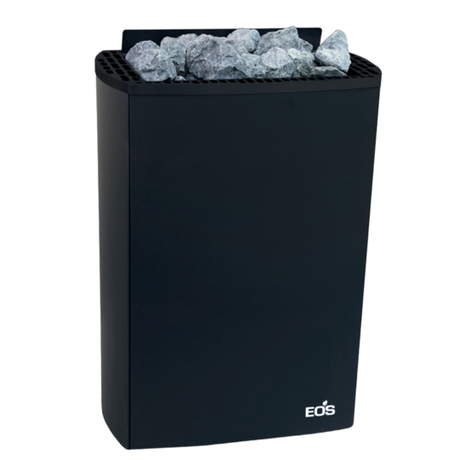
EOS
EOS Moment W Assembly and operating instruction
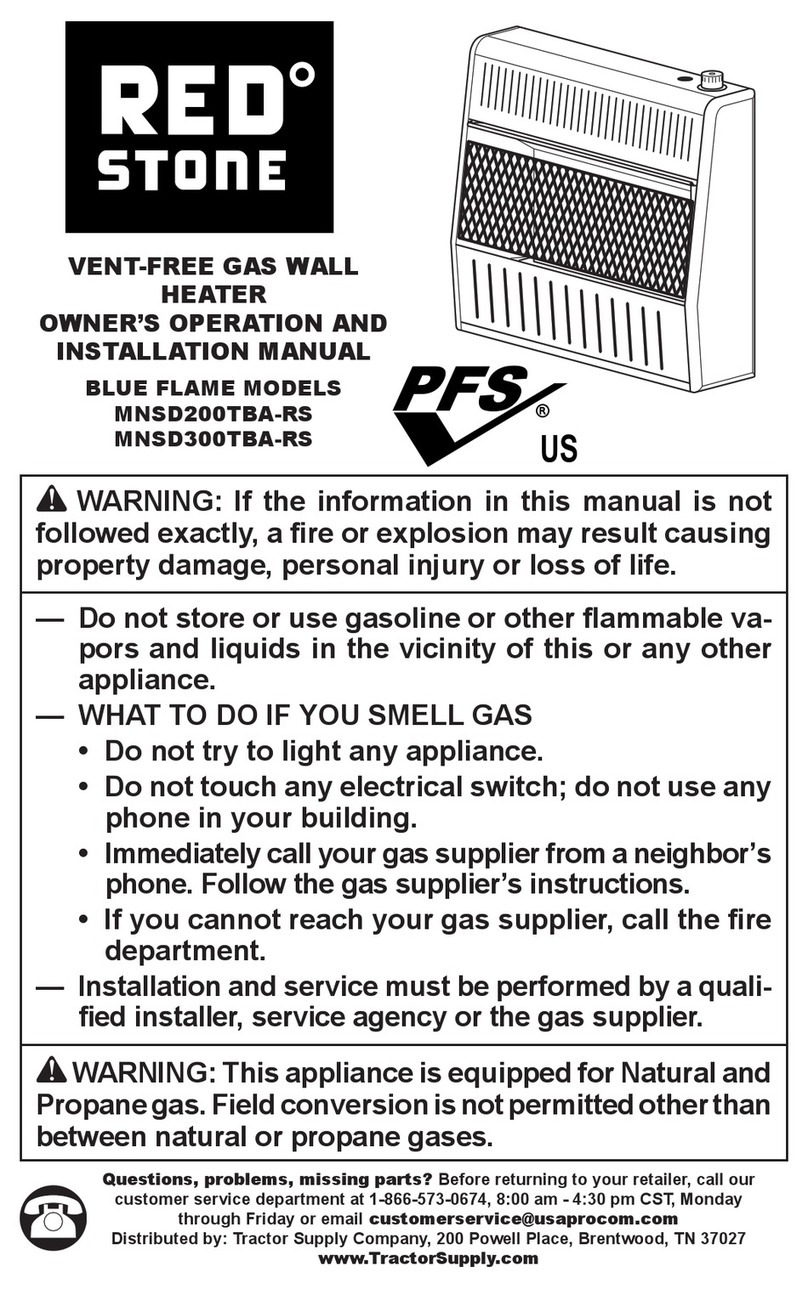
Red Stone
Red Stone MNSD200TBA-RS OWNER'S OPERATION AND INSTALLATION MANUAL
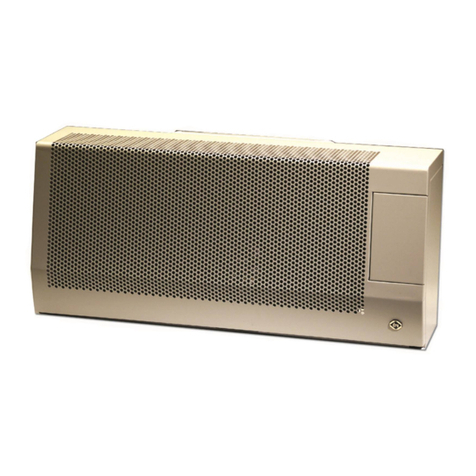
Dru
Dru NL 31 Instructions for installation and operation

Plein Air
Plein Air CMO-1500 instruction manual
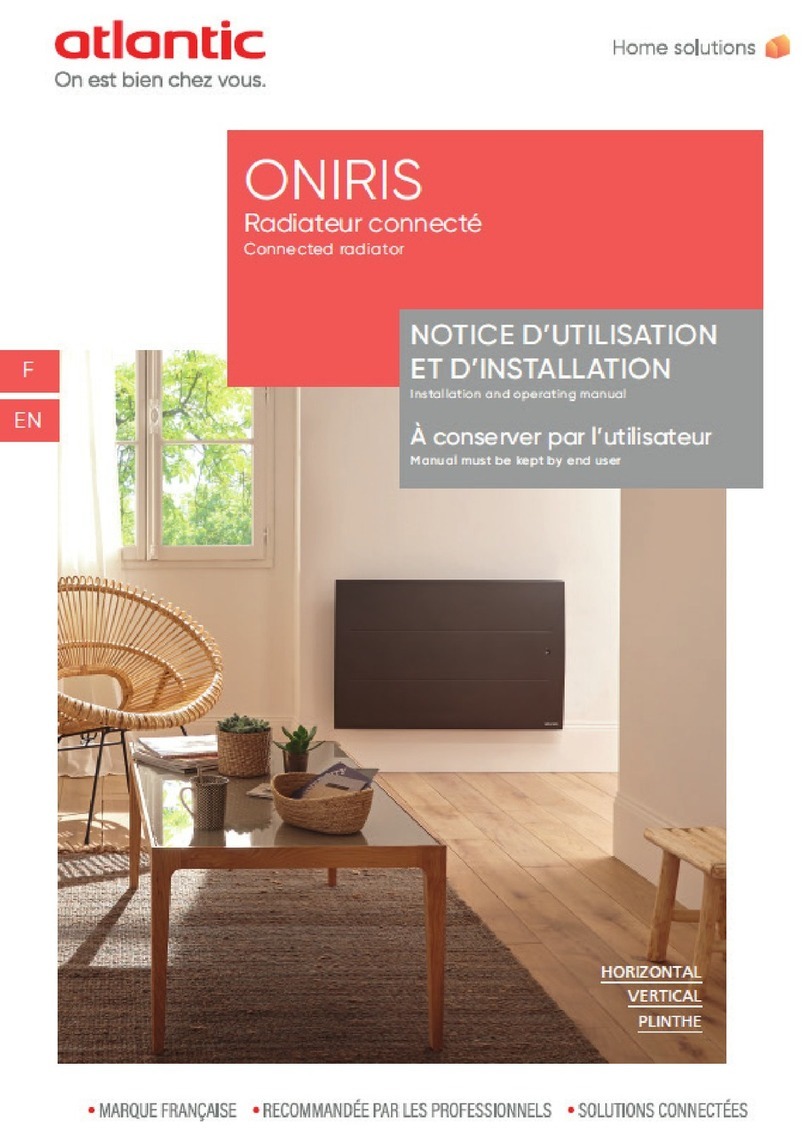
Atlantic
Atlantic Oniris RAF3H-i2g manual
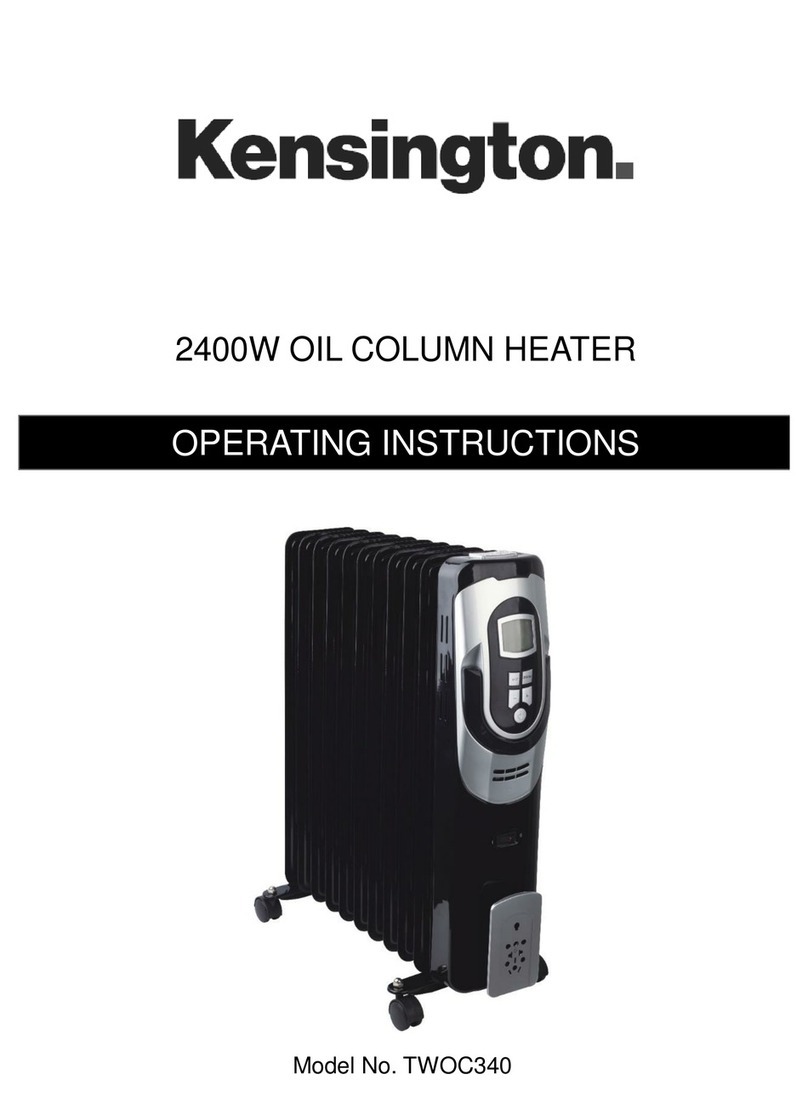
Kensington
Kensington TWOC340 operating instructions
